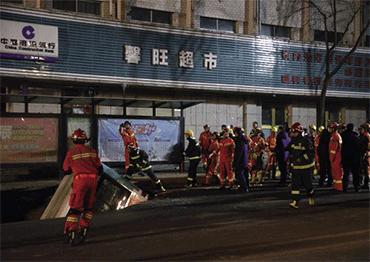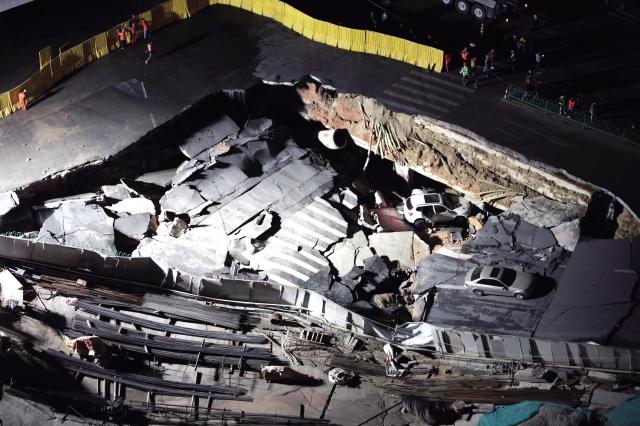Ma Chao, 36, did not expect that waiting to board a bus would result in a near-fatal accident. Ma, who lives in Xining, western China’s Qinghai Province, was lining up for the No.17 outside the city’s Red Cross Hospital after visiting his ill son, he told NewsChina.
It was 5:36 pm when the bus pulled up. Ma was about to board at the front, when there was a loud crack and the ground gave way beneath his feet. Ma, along with the bus, passengers and other pedestrians were swallowed by a sinkhole. Although people rushed to the rescue immediately, nine people died, and one is missing, presumed dead. Ma counts himself lucky to have survived.
The Xining sinkhole is the last and worst of a spate of similar incidents, caused by land subsidence, either by natural erosion or by shoddy underground construction.
Footage shot by a surveillance camera which went viral online showed the bus plunging into the sinkhole. People at the front could not escape. The hole continued to enlarge, swallowing a nearby lamppost. Some bystanders, including a child who went back to try to rescue people, disappeared into the hole. Then there was an explosion.
Ma said he had not noticed anything unusual before the incident. Talking to NewsChina on January 14, he said he plunged even faster than the bus. “There was a lot of water in the hole already, and I suppose the underground pipeline system must have been damaged earlier, since it was almost flooded,” he said.
People were terrified and ran away as fast as they could. Retired army soldier Sun Wanhong and his family were passing by and saw a survivor clinging to the edge of the hole, crying for help. Sun and a few others who went to their aid were also engulfed by the spreading sinkhole.
Sun said the explosion happened right after he fell. But, he told NewsChina, it was deep in the hole and so they were not injured.
“People including me started to try to rescue ourselves,” Sun said. They first helped drag out a teenager and two children buried in the mud. Then survivors tried to find a stable place to stand, waiting for professional rescuers to arrive. They came around 10 minutes after the incident with diggers and other equipment to excavate the ground around the collapse site. Mud-covered survivors were hauled out of the hole by rope. Some of the bus passengers were able to clamber through a window before being pulled to safety. Chen Ying, a grocery store owner near the bus station, saw everything. “There weren’t many passengers on board. It was passersby outside the bus who mainly got injured,” Chen told the reporter. According to a State media report that night, all the bus passengers were accounted for when the bus was lifted from the hole.
Rescue crews worked the whole night to search and help trapped people, most of whom were rescued from the collapsed 80-square-meter pit in the street. After a search and rescue operation lasting more than 80 hours, 17 injured people were rescued and the bodies of nine victims recovered. One woman remains missing.
At a press conference on January 17, Xining government said that all efforts had been made to try to find the missing woman, but due to the unstable geological situation which could threaten nearby buildings, the search had to be called off.
By February 2, 20 days after the incident, no official announcement of the exact cause of the sinkhole had been made.
A preliminary investigation into the Xining sinkhole indicates it could have been caused by broken underground water pipelines. In recent decades, there have been many similar incidents. It is feared that the Xining sinkhole is the tip of the iceberg when it comes to the danger posed by land subsidence in urban areas.
According to statistics from the Shenzhen Geology Environment Monitoring Center, Guangdong Province, from 2013 to 2017, in Shenzhen alone, there were more than a thousand incidents of subsidence.
“Land subsidence has happened a lot in recent years,” said Lei Chengbin, a senior engineer from the Shenzhen monitoring center. Lei found that in some 400 cases of land subsidence, 50 to 60 percent of the total incidents from 2013 to 2017 were caused by broken underground pipes. These pipes, most of which were installed after the 1980s, have a life cycle of 30-40 years. Additionally, the high density of underground construction has caused damage to the pipeline network.
On December 1, 2019, at the construction site of Shahe subway station in Guangzhou, Guangdong Province, land subsidence trapped three workers, who did not survive. On December 12, in Xiamen, Fujian Province, a 500-square-meter sinkhole opened up in Siming District, swallowing two cars, including a taxi. The occupants were able to climb out. Both were caused by subway construction. Yet another sinkhole, in Hangzhou, Zhejiang Province, on August 28, 2019 was caused by a water leak at the construction site of a new subway line. No casualties were reported. On August 23, 2016, there were three land subsidence incidents in Lanzhou, Gansu Province. There were no deaths.
China is not the only country to be affected. In Guatemala City, Guatemala, a sinkhole in 2010 swallowed a three-story factory, although only one person was suspected to have died. Detroit in Michigan has seen a series of sinkholes open up, large enough to swallow vehicles. A huge sinkhole opened in Detroit on March 28, 2014, almost swallowing a Cadillac, and one on December 24, 2016 caused by a ruptured sewer line destroyed part of a house. The whole street had to be evacuated, media reported.
“Compared to many other sinkholes which had natural causes, the one in Xining is very serious and quite unprecedented,” engineer Yuan Jiayu of the Shanghai Geotechnical Engineering Detection Center told NewsChina in late January. Yuan said that as far as he knew, there were few deaths caused by sinkholes attributed to non-natural causes before the Xining one. The most serious occurred on May 20 in 2013 in an industrial park in Shenzhen where a sinkhole engulfed an entire building complex, resulting in five deaths and one injury.
That incident prompted Yuan to research land subsidence in urban areas. As urbanization has increased in the last decade, he found frequent occurrences of land subsidence due to geological conditions and insufficient road bearing capacity. He suggested that the Xining incident might have an underlying natural cause, since the area is predominantly loess, prone to collapse. Loess soil is strong in dry conditions, but unstable once immersed in water. Also in Xining, civil air defense projects were built in earlier decades and “these could be what caused the soil erosion,” Yuan said.
Air defense projects have resulted in collapses before. Yao Xuehu, an expert in geophysics, said that the problem is more serious in northern China than the rest of the country, including collapses in Harbin, Heilongjiang Province, Zhengzhou in Henan Province, and in Lanzhou. It was confirmed later that near the Xining collapse is an underground air defense tunnel. An official from Xining government, who asked not to be named, told the reporter that the tunnel is 20 meters underground, was built in the 1960s to 70s and is around 9 meters from the sinkhole. According to the official, after the incident, there was also a collapse in the tunnel. Local authorities dispatched rescuers to the tunnel to search for the missing woman, but she was not found. In mid-January, when NewsChina visited the site of the collapse, there were still people with equipment conducting tests. The official said there had been regular inspections in August and October 2019 which did not detect any water leaks. He added that there was no concrete evidence yet linking the sinkhole to the defense tunnel. The real reason for the collapse is still to be established.
NewsChina learned from witnesses and survivors that a water pipe was broken in the large underground pit which resulted in the flooding at the bottom of the hole. Zhou Min, an official from Xining Water Supply Group told media that the pipe was broken by the falling bus. However, the reporter learned from the local authority that it is not yet confirmed whether it was already broken, or the bus caused it.
The reporter learned from local business owners and residents that 15 to 20 minutes prior to the disaster, the water supply to four stores opposite the bus station was cut. Three of the store owners said that since the morning of January 13, the flow of tap water had been less than normal. Some also mentioned there had been excavations to carry out repairs to pipes in the area during the previous summer.
Nine days after the Xining incident, Chinese Premier Li Keqiang inspected the site of the sinkhole. Li cautioned that local authorities should start strict inspection, check the security of urban public infrastructure and ensure the quality of new construction projects, particularly underground sections.
“Soil erosion caused by pipeline defects is a hidden problem. Problems are random and cause long-term impacts. Day-to-day inspections can’t really spot these problems,” said Yuan Jiayu. Naturally caused land subsidence is a frequent issue, he said.
Liu Huizhong, deputy secretary general of the Underground Pipeline Committee of China Association of City Planning, told the reporter that domestic administrative measures taken to address such issues come mostly in the wake of emergencies, and they cannot solve the prevailing problem in the long term. He suggested following the successful experience of Japan. “We should conduct regular inspections, particularly in key regions, roads, areas along subway lines, or above water supply pipelines,” Liu said. A common method to test for underground holes is to use vehicle radar systems. According to the Beijing News, Japan has been using radar testing for road maintenance for over 20 years. Designated companies conduct regular checks on key roads in Tokyo, and if there are any hazards spotted, road authorities deal with them swiftly. Those in charge of underground pipes will check them and give maintenance recommendations to road authorities.
Yuan also recommended the experience and practices of Shenzhen should be considered by other cities. Since 2013, there have been 200 incidences of land subsidence in Shenzhen. Shenzhen municipality set up a special department named the Shenzhen land subsidence prevention leading group. The group was led by the then-executive vice mayor who called for united efforts across government to work together in addressing the problem. In 2014, the city government decided to invest 800 million yuan (US$114.6 million) annually for three years on prevention measures. First, inspections of drainage pipelines were conducted, with more than 20,000 potential problems found. Through radar testing, over 2,000 holes were spotted underground, and follow-up measures were taken. Lei Chengbin, former vice director of the Shenzhen leading group, told NewsChina that it has become normal practice in Shenzhen to hold regular inspections of pipelines. Annually, these inspections cover around one-fifth of all pipelines within the city, with a full check taking five years. National standards call for only 5 percent of pipelines to be checked each year.
“Although land subsidence still happens quite a lot in Shenzhen, we don’t see too many deaths or injuries because of the effective preventative measures,” said Lei, who admitted that it is impossible to prevent small incidents. “It’s not practical to change all the old pipelines and human activities such as constructing subway lines can’t be stopped,” he said.
But not all cities have the financial resources to copy Shenzhen. A geologist, who asked for anonymity, told the reporter that in general, local governments did not pay sufficient attention to the issue. “Most land subsidence accidents have happened since 2009 in China, and they will continue to happen.”
“It is of paramount importance to learn lessons from these deadly incidents and draw the attention of local governments. It’s like the city itself getting ill and needing medical treatment.”

 Old Version
Old Version

